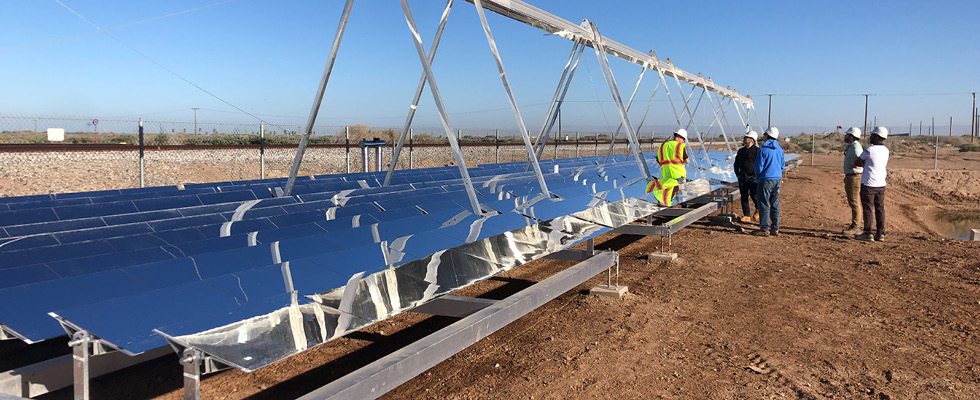
In April, Oberon Fuels, a renewable fuels provider, announced a purchase agreement with Sunvapor on a solar steam project that would aim to increase the output of renewable fuels. Knowing Oberon’s commitment to the advancement of renewable dimethyl ether (rDME) and the advantages it could provide to reducing the carbon intensity of propane, BPN asked Elliot Anise-Hicks, chief technology officer and co-founder of Oberon Fuels, to provide background information on the solar steam project and what it could mean for the potential impact on the future of renewable fuels, and specifically renewable propane.
Can you give a brief background on the solar steam project?
While Sunvapor had previously installed solar steam in commercial operations, the project with Oberon was their first using a thermal battery. By storing steam in the battery, they can provide us with renewable heat even after the sun goes down. Oberon’s Maverick Innovation Center in Brawley, California, was a good fit for a commercial test system — we need heat 24/7 to run the renewable DME process, and there is lots of sunshine in Brawley!
The project is supported by a Department of Energy initiative to develop technologies that provide sustainable heat for industrial applications. Implementation of the equipment has been completed and the solar steam process is going through commissioning and integration into the Maverick operations. Once complete, the Sunvapor process will provide renewable steam for production of renewable DME for at least the next five years under the power purchase agreement (PPA).
How does the solar steam technology work with Oberon’s facilities and the production of renewable DME?
Renewable DME production, like many chemical processes, requires heat that is provided by steam. Oberon’s Maverick facility includes a conventional steam boiler to run the process. The Sunvapor system delivers steam to the same input point on the process as the steam boiler, reducing the need for steam from the conventional boiler. And because this renewable steam is going through a thermal battery, the steam can continue to be delivered after the sun goes down. The system at the Maverick plant is designed to offset a portion of the steam needed for the process. Based on data from this initial system, we can deploy systems at future projects that increase the amount of solar steam production and the size of the thermal battery to further drive down the carbon intensity of Oberon’s rDME fuel.
In what ways does it increase output and lower carbon intensity for renewable fuels?
Carbon intensity is calculated using all of the energy inputs needed to produce a fuel. Heat for the process supplied with conventional fossil sources will then increase the carbon intensity of the product. Alternatively, the heat can be provided by consuming the renewable feedstock for the plant, which keeps the carbon intensity down, but also reduces the amount of product that can be made. Solar steam bypasses this trade-off, allowing us to keep carbon intensity levels down without sacrificing production volume.
Can you describe the importance of strategic partnerships like this in helping to advance net-zero goals in the U.S.?
Solar steam is an excellent example of an emerging technology that can make sustainable fuels like renewable DME even better. However, there are other emerging technologies that can reduce carbon intensity through waste heat recovery, industrial heat pumps, process electrification, feedstock processing and many more. Traditional project financing makes it a challenge to integrate new technologies into commercial projects — even with better performance, new tech introduces risk that makes financing more expensive. The PPA structure helps to mitigate risk and financing burden on the projects, enabling more projects to be greenlit to deliver more renewable gallons faster. The energy transition is not limited by available feedstocks, land or technology, but by the speed with which we can deploy capital.
How could this project advance the road to renewable propane specifically?
Globally, the liquefied petroleum gas (LPG) market is similar in emissions footprint to aviation fuel. To date, renewable propane has been limited to being a byproduct of biodiesel production. There is a long way to go to develop enough renewable molecules to significantly impact the global supply. Whether new projects are built to produce renewable DME or propane, process heat will be required, and solar steam will be an available tool to reduce the carbon intensity of the end product.
Are there things propane companies can do to enable more widespread incorporation of renewable energy into the market?
Governments around the world are going to continue to push to reduce the carbon intensity of their national energy mix. This will occur at a different pace and in different forms by country, and even within a country — California’s Low Carbon Fuel Standard incentivizes low carbon intensity propane far more than most other states. Whatever the pace, the global trend is toward decarbonization, and propane companies need to be ready to adjust. Incorporating renewable propane and DME into operations now, even on a limited basis, will provide the operational experience needed as the regulatory and market environment changes.
Should the propane industry continue to keep an eye on the renewable DME space as the push for renewable energy increases? If so, why and what are the benefits?
The propane industry is projected to be short on renewable molecules for decades into the future. Renewable DME will be an important part of the transition for the propane market, offering a near-term path to significantly lowering carbon intensity. Additionally, DME has advantages in other applications, including as a means to store and transport hydrogen. As the hydrogen market evolves, the ability to use the existing propane industry infrastructure to safely and cost effectively deliver hydrogen will be a massive opportunity for propane companies.
Anything else you’d like to address?
The energy transition will disrupt many established industries, but also create new opportunities for growth. Embracing new technologies and processes will require creativity in all aspects of how we operate our businesses, but the rewards for navigating these changes will be immense and far-reaching.


